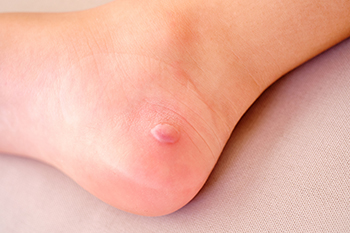
Preventing sock blisters involves considering several key factors. Choosing the right sock material is vital, as synthetic blends or merino wool are excellent options because they wick moisture away from the skin and reduce friction. Cotton socks, on the other hand, tend to retain moisture, increasing the risk of blisters. Ensuring the correct sock size is also essential. Socks that are too tight can cause pressure points, while those that are too loose can create folds that rub against the skin. Additionally, the construction of the sock matters, as seamless socks or those with flat seams minimize irritation. Padded socks can provide extra cushioning and protection in high-friction areas. Paying attention to these details can significantly reduce the likelihood of developing painful sock blisters during activities. If you have developed blisters that have become infected, and would like to know if the socks or shoes are causing them, it is suggested that you consult a podiatrist who can offer correct treatment and prevention strategies.
Blisters may appear as a single bubble or in a cluster. They can cause a lot of pain and may be filled with pus, blood, or watery serum. If your feet are hurting, contact one of our podiatrists of William Street Podiatry. Our doctors can provide the care you need to keep you pain-free and on your feet.
Foot Blisters
Foot blisters are often the result of friction. This happens due to the constant rubbing from shoes, which can lead to pain.
What Are Foot Blisters?
A foot blister is a small fluid-filled pocket that forms on the upper-most layer of the skin. Blisters are filled with clear fluid and can lead to blood drainage or pus if the area becomes infected.
Symptoms
(Blister symptoms may vary depending on what is causing them)
- Bubble of skin filled with fluid
- Redness
- Moderate to severe pain
- Itching
Prevention & Treatment
In order to prevent blisters, you should be sure to wear comfortable shoes with socks that cushion your feet and absorb sweat. Breaking a blister open may increase your chances of developing an infection. However, if your blister breaks, you should wash the area with soap and water immediately and then apply a bandage to the affected area. If your blisters cause severe pain it is important that you call your podiatrist right away.
If you have any questions, please feel free to contact one of our offices located in William Street in New York, NY, Forest Hills, NY, and Broadway in New York, NY . We offer the newest diagnostic and treatment technologies for all your foot care needs.

